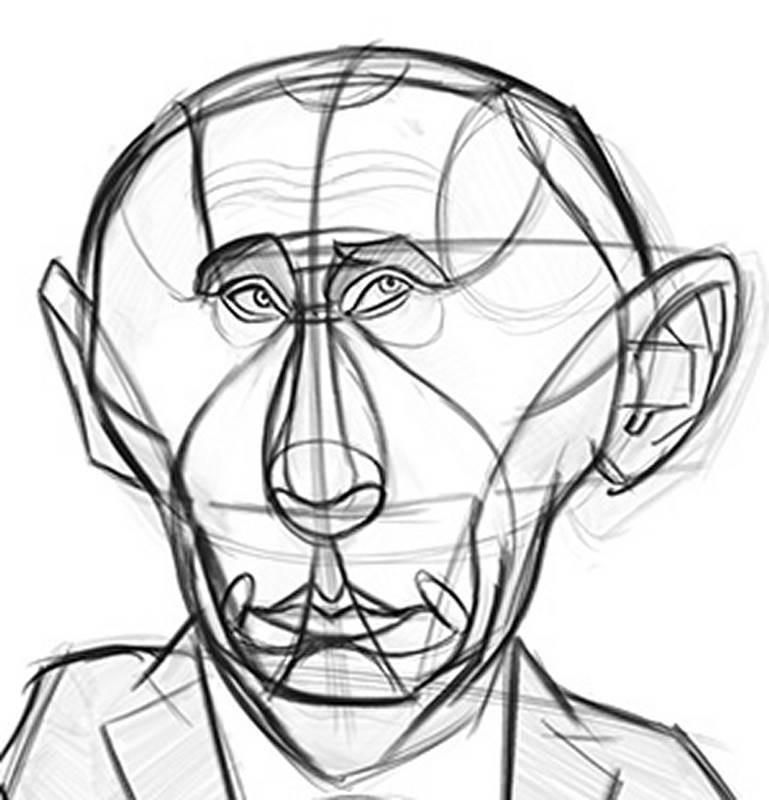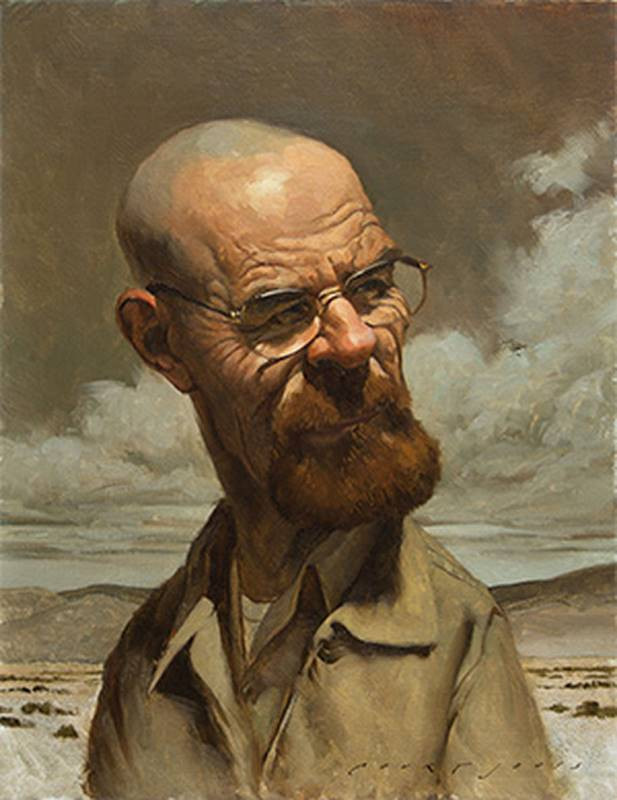Art of Caricature
Thanks everyone who followed along through the whole course. I hope you all found value in it. Sometimes it got pretty technical. The reason I designed this course the way with all the lessons breaking down caricature-making into several different steps is because I think that’s the best way to draw and to learn to draw. It’s about starting simply and then building complexity on top of it. That’s why the fundamental course breaks down the caricature drawing process the way it does.

1. Learn the fundamentals of caricature: Exaggeration, Likeness, Correcting Errors and Careful Rendering. You will have an easier time if you have strong fundamental skills.
Most of the problems I see in students’ work are fundamental drawing problems. Master your fundamental skills because that is the foundation you’ll build everything on.
The second half of the course is good and has helpful drawing strategies, with many ways to overcome roadblocks.
2. One of the most valuable lessons from the course is the checklist: [caricature to-do lists] that describe everything you notice about the subject’s likeness. They help you organize your thoughts, set your intention and figure out what you want to do with the caricature.
Doing the work
Watching the videos over and over won’t do much for you if you don’t sit down and do the work. It would be like if you only watched exercise videos, but never moved a muscle. Just knowing how the exercises are done won’t make you stronger. You need to get to the gym and lift those weights. Caricaturing is the art of making good decisions on the spot about what to change in your subject’s face. Just knowing what a caricaturist does is not enough. Only through your own application of those lessons will you build the mental tools to know what to do when you sit down at the drawing desk to try and draw a face.
3. Don't just watch the lessons. Apply the lessons with constant practice and sketching faces. Repetition of good procedure will make you better at making your own exaggeration decisions.
Mindset
Drawing caricatures requires a particular mental attitude or freedom from restrictions you place on yourself than it does any particular techniques or skills. You can’t worry about how your sketch may insult or offend. When you’re doing commissions or political caricature, that can be something in the back of your mind which will prevent you from drawing to your full potential.
4. Don't worry about how the world will react to your caricatures or try to second guess what will please them. Follow your own instincts. Trust your judgment because you are the one who has trained and practiced this art form. Not them.
Perfection and Mistakes
Strive for excellence in your art. But don’t worry about making any piece “perfect.” Digital painting makes it tempting to go for a perfect look.
5. Strive for excellence, but not perfection. There is no artistry in perfection. The imperfections are what make your own style unique and interesting.
The imperfections we all have in our art are part of our individual style and voice. And your unique voice is what is going to attract people to your work. Think about the artists you like. Why do you like them and keep coming back to look at them? Sargent didn’t paint every strand of hair or every wrinkle in a dress. He simplified things and used his imperfect tools in a way that only he could do.
Your subject matter isn’t all that important in caricature or art in general. I don’t look over Sargent’s work repeatedly because of the subject. It doesn’t matter what he painted, but HOW he painted it. A sun-drenched mountainside is just as interesting as how he painted a lady’s eyes. Sargent made those things interesting because of HOW he painted them. His values, his composition choices, his color palette, the thickness of his strokes.
Camaraderie
To keep yourself motivated and to learn from others find a group to help encourage you to draw more: Competition groups on social media can help keep you active in the art form and motivate you to push yourself.
6. Find your tribe. In life and your career, try to surround yourself and spend time with the type of artists and the type of people you want to be like. Join organizations and participate in competitions.
You can join a networking group like International Society of Caricature Artists (ISCA). I’ve met some of my best friends and even my wife at the ISCA convention.
Earning a Living with Caricature
There are quite a few things you can do with caricature as an artist. These are some of the things I’ve done: live caricatures at theme parks or events, private commissions, editorial illustration, packaging and promotional illustration, Halloween mask design, book covers, character design for animation. You can even apply caricature principles about consciously controlling how you design a face to traditional illustration and portraits. Everyone could benefit from the pressures of working in a Quicksketch environment.

7. You can make a good living doing caricatures. A great way to start is drawing quicksketch caricatures in theme parks. You learn how to apply these skills in real world situations and can learn from more experienced artists.
Caricature is everywhere. Everyone does caricature to some degree in their artwork. The principles can be applied to whatever type of illustration you end up doing, and it is good to have the skills to work in mutliple art styles.
8. Caricature can mean many things and is one of many tools in your artist's toolbox to make a living as an artist. It's good to be flexible and to be comfortable controlling and changing what you see in your subject to achieve a particular effect. Caricature can open many doors and new opportunities.
Live caricature in a retail or theme park setting is the entry point for most caricaturists I’ve known. It’s great training. But it’s not for everybody. You need to figure it out for yourself. Maybe you’d rather stay in the studio and only do paintings and illustrations.
Live quicksketch to me is like live improv sketch comedy. It’s hilarious and brilliant when it works. But terrible when it doesn’t. You have to work with the subject you’re given and quickly adapt to the situation. You need to have real skills to pull it off. Fine art and illustrative caricatures are more like making a movie and you’re the director. You can cast it with whoever you want. Figure out the lighting. Spend a long amount of time creating it and editing it. Both take skills. And they’re related but definitely different beasts.
9. What kind of caricature do you want to do? What is your temperament? You may be more suited to live quicksketch or you may be better at studio caricature illustrations and paintings. Maybe you'll be able to do both. I recommend you try.
Looking Forward
10. Don't worry if you don't see immediate success in caricature. It can take a long time. Everyone learns at their own pace. And how fast you improve is up to you and how frequently you practice.
It can take a really long time to get your skills and abilities where you want them to be, where you feel like you’re at a professional level with other people you admire. And even when you get there, not every sketch is going to be a winner.
11. Not to discourage you, but caricature never gets easier. You will always struggle and hit roadblocks along the way. But you do eventually trade in your old problems for new ones. After you master your fundamentals, you will find new issues to frustrate you. But that means you are functioning on a higher level than you were before.
Once you have a solid fundamental skill set, then you need to work on problems of a more subtle nature.
Once you get a handle on structure and perspective, for instance and can see when your drawing is off, then you notice new things that bug you about your values and edges in the final rendering. But that’s also exciting, because it means there’s always going to be something new to learn, some new way to better yourself.
12. The great thing about the nature of being an artist is that there is no upper limit to how far you can go or how good you can get. And that prospect is exciting. The learning never stops (hopefully!).
Shameless Self Promo
Now that I’m not doing Proko course stuff, I’ll have more time to post my own videos on my YouTube channel and photos on my Instagram.
Premium
So, we’ve gone through all the Caricature lessons, from the fundamentals to the final render, to Spirit Animals and Shape Design. But there’s still so much more for you to see... in the Premium section.
I have a bunch of content not available in the free course, including extended lessons, over 13 hours of critiques, exclusive episodes, and over 90 narrated demos that hammer in what you’ve learned from the main lessons!
Thank you for watching, and I hope you decide to get the premium course. Your support is what makes these lessons possible for both the free and premium students. If you’re interested in caricature, I know you would get a lot out of it.



